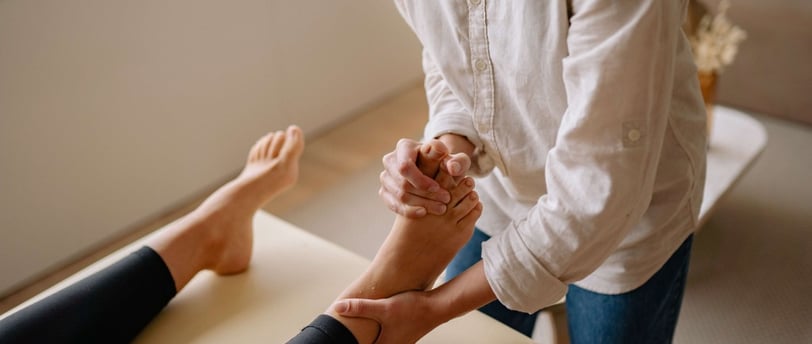Harnessing Ancient Healing: The Transformative Power of Reflexology
In a world increasingly driven by digital demands and fast-paced living, the wisdom of ancient healing practices offers a potent antidote to modern stresses. Among these time-honored traditions, reflexology, or "ancient foot healing," stands out as a profound and accessible pathway to holistic well-being.
7/9/20253 min read


In a world increasingly driven by digital demands and fast-paced living, the wisdom of ancient healing practices offers a potent antidote to modern stresses. Among these time-honored traditions, reflexology, or "ancient foot healing," stands out as a profound and accessible pathway to holistic well-being.
Far more than just a simple foot massage, reflexology is a complementary therapy rooted in the belief that specific points on the feet, hands, and ears correspond to various organs, glands, and systems throughout the body. Evidence of such practices dates back thousands of years, suggesting a universal understanding of the feet as a powerful gateway to overall health.
A Glimpse into History: Roots of Foot Healing
The practice of applying pressure to the feet for therapeutic purposes boasts a rich and fascinating past. A glimpse into history: roots of foot healing reveals its presence in ancient civilizations across the globe.
Pictographs found in the tomb of an Egyptian physician, Ankmahor, dating back to 2330 BC, depict individuals receiving treatments on their hands and feet. Similar practices are documented in ancient China, India (as part of Ayurvedic medicine), and among Native American cultures.
While the exact origins are debated, these historical records underscore a shared ancient belief in the interconnectedness of the body and the therapeutic power of stimulating specific areas of the feet. This enduring legacy suggests that humans have long recognized the feet as vital centers for healing and balance.
The Core Principle: Reflex Points and Energy Pathways
At the heart of reflexology lies the core principle: reflex points and energy pathways. The fundamental theory posits that specific "reflex points" on the feet (and hands and ears) are energetically linked to various organs, glands, and body parts.
When these reflex points are stimulated through specific pressure techniques, it's believed to send signals along energy pathways (often referred to as "zones" or "meridians," though distinct from Chinese medicine's meridians) to the corresponding areas of the body.
This stimulation aims to clear blockages in the flow of vital energy (often called Qi or Prana), restoring balance and prompting the body's natural healing mechanisms. While modern science continues to explore the exact neurological mechanisms, proponents suggest it may work by calming the central nervous system, reducing tension, and promoting the release of natural pain relievers like endorphins.
Modern Benefits of Ancient Practices
The ancient wisdom of reflexology offers significant modern benefits of ancient practices relevant to contemporary health challenges. One of the most widely reported benefits is profound stress reduction and relaxation.
By targeting nerve endings in the feet, reflexology can help shift the body from a "fight or flight" sympathetic state to a more relaxed parasympathetic state, leading to reduced anxiety and improved sleep quality.
Beyond stress relief, many individuals report improvements in circulation, which aids in nutrient delivery and toxin removal. It's also frequently sought for pain management, including headaches, back pain, and joint discomfort.
While not a substitute for medical treatment, reflexology is often used as a complementary therapy to support overall well-being, boost the immune system, and promote the body's natural self-healing capabilities.
The Reflexologist's Touch: Skill and Intuition
The efficacy of reflexology hinges on the reflexologist's touch: skill and intuition. A trained reflexologist employs specific techniques, such as "thumb walking" or "finger walking," applying precise pressure to various reflex points.
They are not merely performing a massage but interpreting the feedback from the client's feet – sensing areas of tenderness or "grittiness" that may indicate imbalances in corresponding body parts.
This requires extensive training, an understanding of the detailed foot maps, and a developed intuition to adapt the session to the individual's unique needs.
The interaction between practitioner and client is crucial, fostering a sense of trust and allowing the body to fully surrender to the therapeutic process, maximizing the healing potential of each session.
Conclusion
Ancient Foot Healing: Unearthing the Timeless Wisdom of Reflexology for Modern Wellness underscores that reflexology is more than a fleeting trend; it is a profound, historically rich practice that continues to offer significant benefits in our contemporary world.
By understanding its ancient roots, appreciating its core principles of reflex points and energy pathways, and recognizing its tangible effects on stress reduction, pain management, and overall well-being, individuals can embrace this accessible therapy.
Whether you seek deep relaxation, relief from specific ailments, or a holistic approach to maintaining vitality, exploring the world of reflexology can truly be a transformative journey for your entire being, starting from the ground up.
Reflexology
Therapeutic practice applying pressure specific points hands ears.
Holistic Therapy
Foot Massage
Foot Reflexology
Reflexology massage
Pain relief therapy
Pressure points
© 2024. All rights reserved. Designed by Pimclick - SEO Agency
